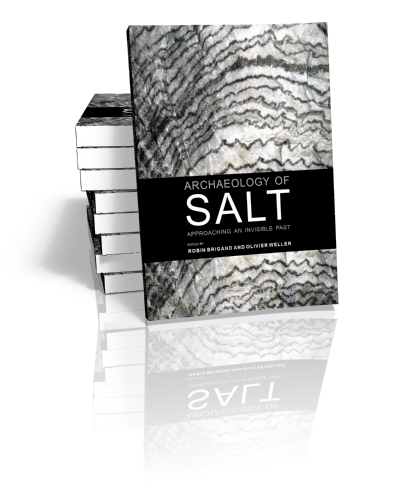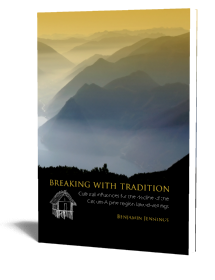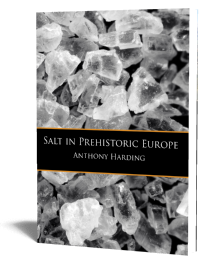Archaeology of Salt
Approaching an invisible past
Edited by Robin Brigand & Olivier Weller | 2015

Archaeology of Salt
Approaching an invisible past
Edited by Robin Brigand & Olivier Weller | 2015
Paperback ISBN: 9789088903038 | Imprint: Sidestone Press | Format: 182x257mm | 228 pp. | Language: English | 25 illus. (bw) | 38 illus. (fc) | Keywords: archaeology, prehistory, salt, european prehistory, neolithic, bronze age, iron age | download cover
Read online or downloaded 3905 times
-
Digital & Online access
This is a full Open Access publication, click below to buy in print, browse, or download for free.
-
Buy via Sidestone (EU & UK)
-
Buy via our Distributors (WORLD)
For non-EU or UK destinations you can buy our books via our international distributors. Although prices may vary this will ensure speedy delivery and reduction in shipping costs or import tax. But you can also order with us directly via the module above.
UK international distributor
USA international distributor
-
Bookinfo
Paperback ISBN: 9789088903038 | Imprint: Sidestone Press | Format: 182x257mm | 228 pp. | Language: English | 25 illus. (bw) | 38 illus. (fc) | Keywords: archaeology, prehistory, salt, european prehistory, neolithic, bronze age, iron age | download cover
Read online or downloaded 3905 times

We will plant a tree for each order containing a paperback or hardback book via OneTreePlanted.org.
Salt is an invisible object for research in archaeology. However, ancient writings, ethnographic studies and the evidence of archaeological exploitation highlight it as an essential reference for humanity. Both an edible product and a crucial element for food preservation, it has been used by the first human settlements as soon as food storage appeared (Neolithic).
As far as the history of food habits (both nutrition and preservation) is concerned, the identification and the use of that resource certainly proves a revolution as meaningful as the domestication of plants and wild animals. On a global scale, the development of new economic forms based on the management of food surplus went along an increased use of saline resources through a specific technical knowledge, aimed at the extraction of salt from its natural supports.
Considering the variety of former practices observed until now, a pluralist approach based on human as well as environmental sciences is required. It allows a better knowledge of the historical interactions between our societies and this “white gold”, which are well-known from the Middle-Ages, but more hypothetical for earlier times.
This publication intends to present the most recent progresses in the field of salt archaeology in Europe and beyond; it also exposes various approaches allowing a thorough understanding of this complex and many-faceted subject. The complementary themes dealt with in this book, the broad chronological and geographical focus, as well as the relevance of the results presented, make this contribution a key synthesis of the most recent research on this universal topic.
Techniques of salt making: from China (Yangtze River) to their world context
Pierre Gouletquer and Olivier Weller
Pre-Columbian salt production in Colombia – searching for the evidence
Marianne Cardale Schrimpff
The salt from the Alghianu beck (Vrancea County, Romania): a multifaceted ethnoarchaeological approach
Marius Alexianu, Felix Adrian Tencariu, Andrei Asăndulesei, Olivier Weller, Robin Brigand, Ion Sandu, Gheorghe Romanescu, Roxana-Gabriela Curcă, Ștefan Caliniuc and Mihaela Asăndulesei
First salt making in Europe: a global overview from Neolithic times
Olivier Weller
A complex relationship between human and natural landscape: a multidisciplinary approach to the study of the roman saltworks in “Le Vignole-Interporto” (Maccarese, Fiumicino-Roma)
Maria Cristina Grossi, Sandra Sivilli, Antonia Arnoldus-Huyzendveld, Alessandra Facciolo, Maria Lucrezia Rinaldi, Daria Ruggeri and Cinzia Morelli
Ancient salt exploitation in the Polish lowlands: recent research and future perspectives
Józef Bednarczyk, Joanna Jaworska, Arkadiusz Marciniak and Maria Ruiz Del Arbol Moro
Prehistoric salt production in Japan
Takamune Kawashima
New data and observations related with exploitation and transport of salt in Transylvanian prehistory (Romania)
Gheorghe Lazarovici and Cornelia-Magda Lazarovici
Spatial analysis for salt archaeology: a case study from Moldavian Neolithic (Romania)
Robin Brigand and Olivier Weller
The salt of Rome. Remarks on the production, trade and consumption in the north-western provinces
Ulrich Stockinger
Competing on unequal terms: saltworks at the turn of the Christian era
Thomas Saile
Salt in Roman Britain
Isabella Tsigarida

Dr. Robin Brigand
Robin Brigand received a Ph.D. in Archaeology from the Universities of Franche-Comté (Besançon, France) and Padua (Italia). He is currently a post-doctorate researcher at UMR 8215 Trajectoires and UMR 7218 LAVUE (Paris, France). His studies on the spatial impact of former societies focus – using various scales – on site systems and their environments, settlement patterns, raw material acquisition and distribution, landscape dynamics, etc.

Dr. Olivier Weller
Olivier Weller is a research fellow at CNRS (UMR 8215, Trajectoires¸ CNRS-Pantheon-Sorbonne University, Paris, France). His research focusses on the archaeology of salt, specifically the origins of salt production in Europe in terms of exploitation techniques, uses and socio-economic implications during the Neolithic. The approaches are both technological, ethnoarchaeological, and ethnohistorical, as well as paleoenvironmental, physical-chemical or geomatic. His study area spans from Europe (France, Spain, Germany, Poland, Romania, Bulgaria) to Oceania (New Guinea).
Abstract:
Salt is an invisible object for research in archaeology. However, ancient writings, ethnographic studies and the evidence of archaeological exploitation highlight it as an essential reference for humanity. Both an edible product and a crucial element for food preservation, it has been used by the first human settlements as soon as food storage appeared (Neolithic).
As far as the history of food habits (both nutrition and preservation) is concerned, the identification and the use of that resource certainly proves a revolution as meaningful as the domestication of plants and wild animals. On a global scale, the development of new economic forms based on the management of food surplus went along an increased use of saline resources through a specific technical knowledge, aimed at the extraction of salt from its natural supports.
Considering the variety of former practices observed until now, a pluralist approach based on human as well as environmental sciences is required. It allows a better knowledge of the historical interactions between our societies and this “white gold”, which are well-known from the Middle-Ages, but more hypothetical for earlier times.
This publication intends to present the most recent progresses in the field of salt archaeology in Europe and beyond; it also exposes various approaches allowing a thorough understanding of this complex and many-faceted subject. The complementary themes dealt with in this book, the broad chronological and geographical focus, as well as the relevance of the results presented, make this contribution a key synthesis of the most recent research on this universal topic.
Contents
Techniques of salt making: from China (Yangtze River) to their world context
Pierre Gouletquer and Olivier Weller
Pre-Columbian salt production in Colombia – searching for the evidence
Marianne Cardale Schrimpff
The salt from the Alghianu beck (Vrancea County, Romania): a multifaceted ethnoarchaeological approach
Marius Alexianu, Felix Adrian Tencariu, Andrei Asăndulesei, Olivier Weller, Robin Brigand, Ion Sandu, Gheorghe Romanescu, Roxana-Gabriela Curcă, Ștefan Caliniuc and Mihaela Asăndulesei
First salt making in Europe: a global overview from Neolithic times
Olivier Weller
A complex relationship between human and natural landscape: a multidisciplinary approach to the study of the roman saltworks in “Le Vignole-Interporto” (Maccarese, Fiumicino-Roma)
Maria Cristina Grossi, Sandra Sivilli, Antonia Arnoldus-Huyzendveld, Alessandra Facciolo, Maria Lucrezia Rinaldi, Daria Ruggeri and Cinzia Morelli
Ancient salt exploitation in the Polish lowlands: recent research and future perspectives
Józef Bednarczyk, Joanna Jaworska, Arkadiusz Marciniak and Maria Ruiz Del Arbol Moro
Prehistoric salt production in Japan
Takamune Kawashima
New data and observations related with exploitation and transport of salt in Transylvanian prehistory (Romania)
Gheorghe Lazarovici and Cornelia-Magda Lazarovici
Spatial analysis for salt archaeology: a case study from Moldavian Neolithic (Romania)
Robin Brigand and Olivier Weller
The salt of Rome. Remarks on the production, trade and consumption in the north-western provinces
Ulrich Stockinger
Competing on unequal terms: saltworks at the turn of the Christian era
Thomas Saile
Salt in Roman Britain
Isabella Tsigarida

Dr. Robin Brigand
Robin Brigand received a Ph.D. in Archaeology from the Universities of Franche-Comté (Besançon, France) and Padua (Italia). He is currently a post-doctorate researcher at UMR 8215 Trajectoires and UMR 7218 LAVUE (Paris, France). His studies on the spatial impact of former societies focus – using various scales – on site systems and their environments, settlement patterns, raw material acquisition and distribution, landscape dynamics, etc.

Dr. Olivier Weller
Olivier Weller is a research fellow at CNRS (UMR 8215, Trajectoires¸ CNRS-Pantheon-Sorbonne University, Paris, France). His research focusses on the archaeology of salt, specifically the origins of salt production in Europe in terms of exploitation techniques, uses and socio-economic implications during the Neolithic. The approaches are both technological, ethnoarchaeological, and ethnohistorical, as well as paleoenvironmental, physical-chemical or geomatic. His study area spans from Europe (France, Spain, Germany, Poland, Romania, Bulgaria) to Oceania (New Guinea).
-
Digital & Online access
This is a full Open Access publication, click below to buy in print, browse, or download for free.
-
Buy via Sidestone (EU & UK)
-
Buy via our Distributors (WORLD)
For non-EU or UK destinations you can buy our books via our international distributors. Although prices may vary this will ensure speedy delivery and reduction in shipping costs or import tax. But you can also order with us directly via the module above.
UK international distributor
USA international distributor
- Browse all books by subject
-
Search all books

We will plant a tree for each order containing a paperback or hardback book via OneTreePlanted.org.
You might also like:
© 2025 Sidestone Press KvK nr. 28114891 Privacy policy Sidestone Newsletter Terms and Conditions (Dutch)







